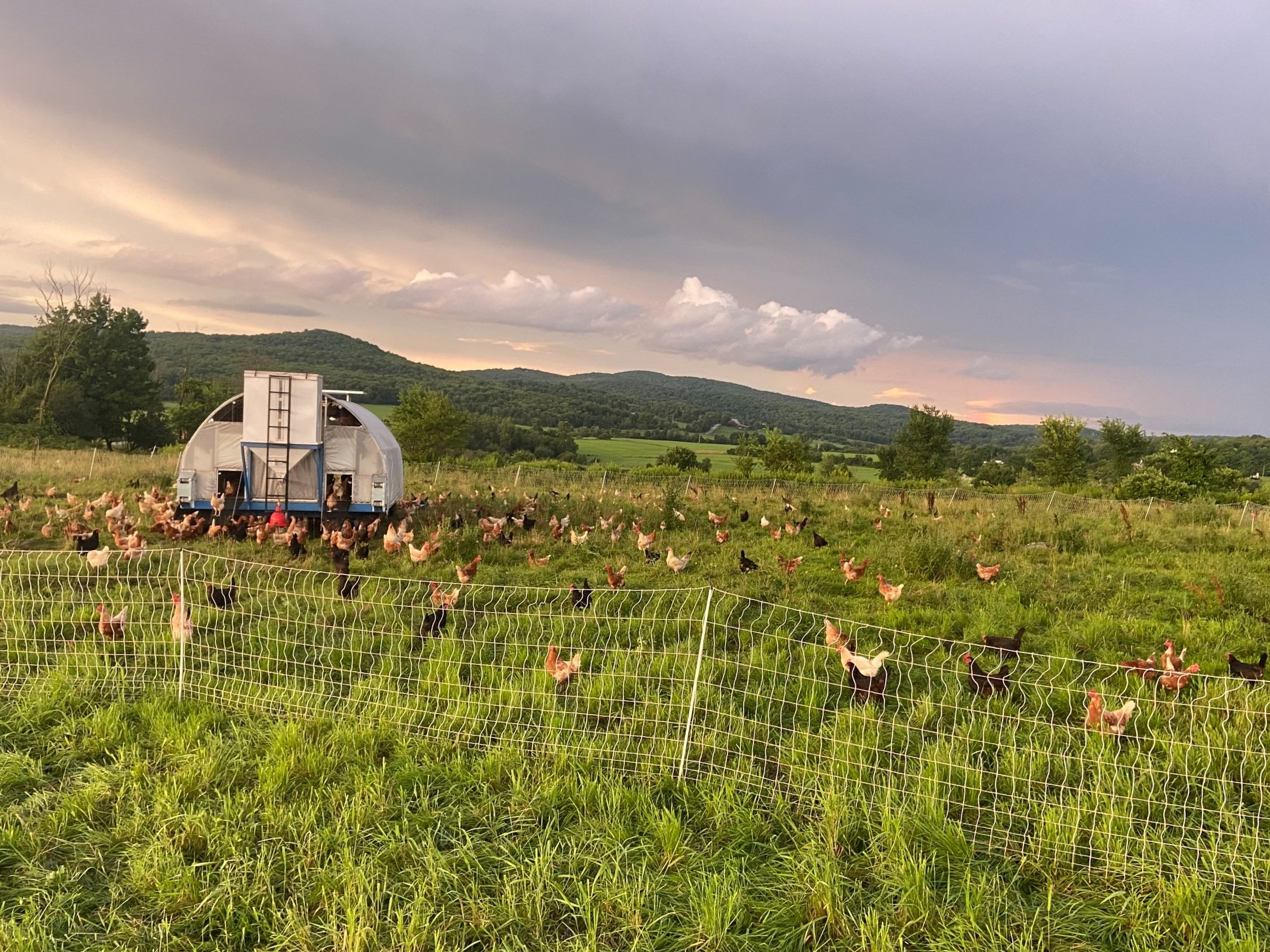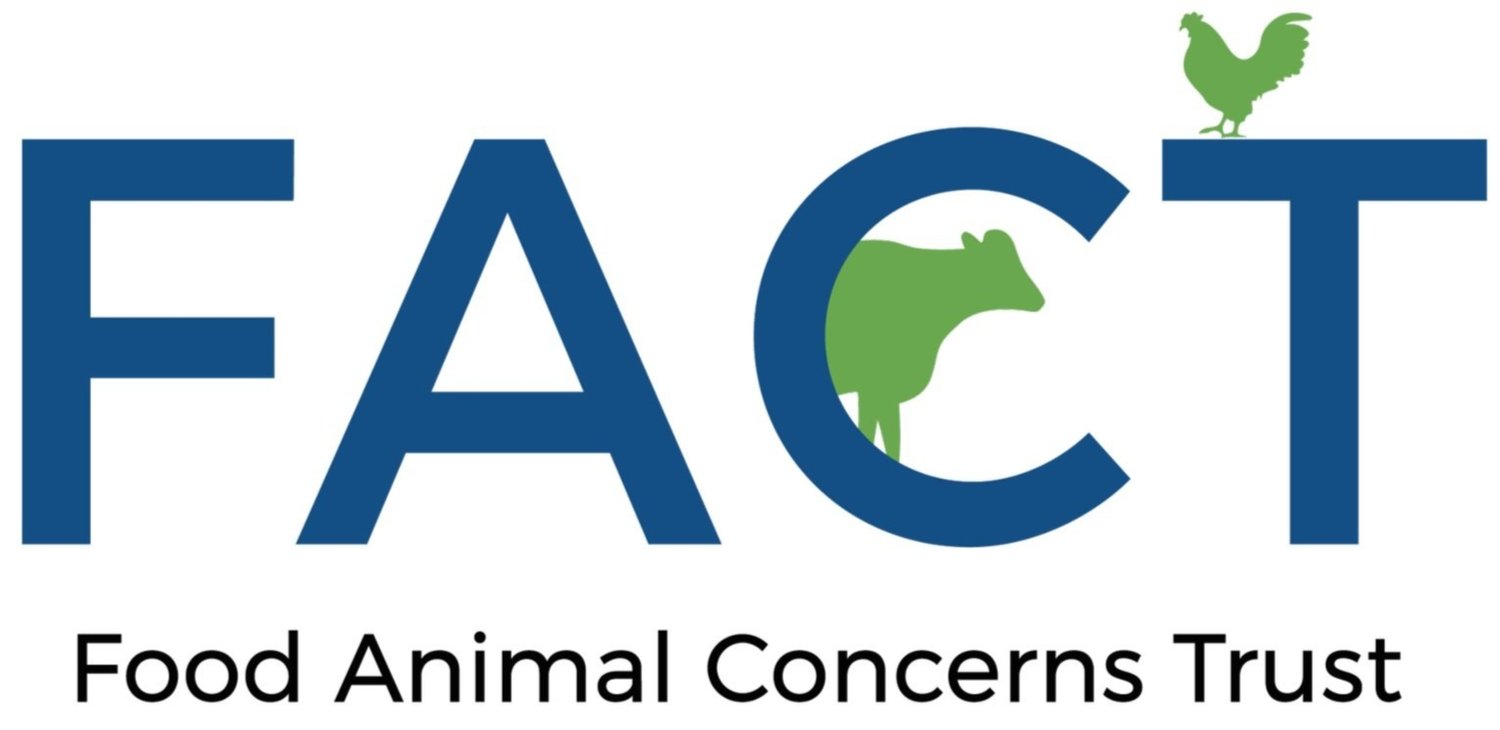
Humane Farming Standards
Hunger Moon Farm
FACT’s Humane Farming Standards
The Five Domains model is an internationally recognized framework for assessing and communicating animal welfare,
particularly useful in livestock farming.
This model encapsulates the physical and environmental conditions impacting an animal's mental state and overall well-being. By applying this model to our Humane Farming Standards, we ensure that livestock intended for food receive comprehensive & compassionate care- from birth to butcher.
Within each domain we outline our general Humane Farming Standards, as supported by A Greener World (AGW), GAP and Certified Humane. For species-specific standards, please see below.
We also recommend that you refer to the ASPCA website for information on food labels and individual species standards.
Humane Farming Standards- by Species
-

SWINE (PIGS)
Swine should not be confined in gestation or farrowing crates, but rather raised in conditions that allow them to have freedom of movement, ideally on pasture.
Pigs should have the ability to engage in natural behaviors—these include wallowing in mud, rooting, foraging, and nesting.
Swine should be allowed to express healthy and safe social interaction. For example, pregnant sows should be kept in groups to allow for socialization and piglets should be kept with their farrowing mates.
Piglets should not undergo tail docking, nose rings, tusk removal or other forms of physical mutilation.
Pigs should receive antibiotics only when medically necessary to treat disease or illness, and only under a veterinarian’s prescription. -

SHEEP
Sheep should have the ability to engage in natural behaviors, such as socializing with flock mates, exercising, and grazing. Living conditions should allow sheep to live and feed without aggression from other animals, including predators and other sheep.
Sheep should not be kept in confinement feeding operations but rather should have continuous access to well managed pasture. Rotational grazing is encouraged.
Lambing should be performed in a safe, clean area (inside or outside) with a competent person available to assist with delivery.
Lambs should be reared with their mothers and the other sheep and lambs in their flock. Weaning should be determined by the health condition of the ewe and her lamb, with preference given to longer weaning times (12 weeks).
Sheep should receive antibiotics only for treatment of disease or illness, as prescribed by a veterinarian. -

LAYING HENS (eggs)
Hens should not be raised in cages or confined spaces, but rather in conditions that allow the birds to have freedom of movement.
Hens should have the ability to engage in natural behaviors—such as preening, running, scratching, foraging and ground pecking, wing flapping, dust-bathing, encounters with other birds, and vocalizing.
All hens should have access to nest boxes and sleeping perches.
Hens should be given daily access to the outdoors with preference given to entirely free-range systems.
Hens should not be subjected to forced molting.
Hens should be raised in conditions that do not necessitate debeaking or beak trimming.
Hens should receive antibiotics only for treatment of disease or illness, as prescribed by a veterinarian. -

BROILER CHICKENS (raised for meat)
Broiler chickens should not be confined indoors, and adult birds should have access to pasture. When on pasture, birds require housing and protection from climatic conditions and predators.
Broilers should have the ability to engage in natural behaviors—such as preening, running, scratching, foraging and ground pecking, wing flapping, dust-bathing, encounters with other birds, and vocalizing.
Broiler should receive antibiotics only for treatment of disease or illness, as prescribed by a veterinarian. -

GOATS
Goats should be raised in an environment that allows them to engage in natural behaviors such as browsing, climbing, jumping, and socializing with members of the herd.
Goats should have continuous access to well-managed pasture. Unlike other ruminants, to maintain health and proper rumen function we encourage access to rangeland, roughage or browse (bushes) as a substantial part a goat’s diet.
Goat Kids should be reared with their mothers and their herd.
Weaning should be determined by the health condition of the doe and her kid, with preference given to longer weaning times.
To ensure the safety, sturdy, effective and well-maintained fencing is required as godts are agile.
To adequately protect from predators, goats should ideally have trained livestock guardian animals living with them while on pasture.
Goats should receive antibiotics only for treatment of disease or illness, as prescribed by a veterinarian. Any sick or injured animals must be treated immediately with antibiotics or other effective treatments to minimize pain and distress. Antibiotics, hormones, implants, or other substances should not be used for purposes other than disease treatment. -

BEEF CATTLE
Beef cattle should be raised on well managed pasture and never be confined on feedlots or other types of confinement feeding operations.
Beef cattle should be fed a natural diet consisting of grasses and pasture-based forage for the entirty of their life, with the exception of milk consumed by calves prior to weaning.
Calves should be reared with their mothers, amongst the herd andshould not be isolated. Weaning should be determined by the health condition of the cow and her calf, with preference given to longer weaning times.
No cattle should undergo mutilations such as tail docking, dehorning, and branding.
Beef cattle should receive antibiotics only for treatment of disease or illness, as prescribed by a veterinarian. -

DAIRY COWS
Dairy cows should have continuous outdoor access to properly managed pastures, and the majority of their diet should be composed of naturally growing roughage and forage to ensure proper functioning of their rumen (the first of a cow’s four digestive compartments).
Milking schedules should be set to ensure cow and calf comfort, with preference given for longer weaning times.
Dairy cows should receive antibiotics only for treatment of disease or illness, as prescribed by a veterinarian.
Recommended all consumers review different dairy brands that incorporate humane treatment of their dairy cows.
Learn more about FACT's humane principles on dairy production. -

BISON
FACT believes that bison should never be kept on feedlots or confinement feeding operations but rather should have continuous access to well-managed pasture or rangeland. Bison should be raised in conditions that allow the adult animals and their calves to have freedom of movement and the ability to engage in natural behaviors, such as socializing, vocalizing, mud/dust wallowing, exercising, and grazing. To ensure proper rumen function, the animals should eat a natural diet consisting of grasses and forage for their entire lives, with the exception to milk consumed by calves prior to weaning. FACT acknowledges that bison are highly adaptable to living without shelter the majority of the time. If needed, animals should have access shelter to protect them from weather extremes. Calves should be reared with their mothers and other bison and calves in the herd, and weaning should be determined by the health condition of the mother and her calf, with preference given to longer weaning time. Bison should receive antibiotics only for treatment of disease or illness, as prescribed by a veterinarian; the use of vaccines, parasite control protocols, and other measures to prevent disease are strongly encouraged.
-

TURKEYS
Turkeys should have access to outdoor ranging and foraging areas from an early age. They should be free to engage in behaviors such as scratching, ground pecking, wing flapping and dust-bathing. Turkeys should be able to forage and seek nutrition from pasture. They should also have clean, well-ventilated housing that is comfortable and provides protection from climatic conditions and predators. Turkeys should be raised in conditions that allow for natural light and dark cycles and must be allowed to molt naturally. They should not undergo debeaking or other forms of physical mutilation such as castration, wattle trimming, desnooding, or detoeing. Turkeys should have access to raised perching areas, nest boxes, dust baths, and continuous access to clean water. The birds should receive antibiotics only for treatment of disease or illness, as prescribed by a veterinarian.
-

WATERFOWL- Ducks & Geese (meat & eggs)
Waterfowl such as ducks and geese must not be confined in cages, crates or indoors for their entire lives. All birds should have access to an outdoor ranging and foraging area from as early on in life as possible. Ducks and geese on pasture should have access to a clean water source, adequate shelter and ideally wading water (e.g. pond, water trough, kiddie pool). Waterfowl should be able to run, bathe, forage and interact with other birds. They should not undergo de-beaking or other forms of permanent physical mutilation such as beak/bill trimming, de-clawing, pinioning or castration. Birds should be allowed to molt naturally. Breeding programs are encouraged to include breeding for reduced aggression and improved health, rather than muscle mass and high growth rate. Breeds should be chosen with consideration of their ability to thrive outdoors in the producer’s climate.


